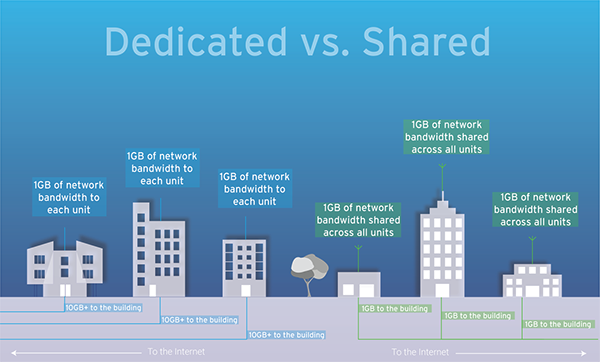Questions to Ask Your Internet Service Provider (ISP)
Jan 25, 2022
As you’ve likely experienced, not all internet service providers (ISP) are created equal. Some are better than others: more reliable, cost less, offer more value, have better customer service, etc. Others, not so much. If you’ve ever switched providers – because you moved or a new provider entered your area – you’ve experienced the inevitable questions that go along with the change.
Is this the best move?
Am I getting the best value and service?
What else should I ask?
To make this transition easier and avoid potential pitfalls, here are some questions we suggest asking when it comes time for a new internet service.
What kind of internet is it? Copper or fiber optic?
There is a huge difference between these two delivery methods. Copper is fine for many slower speed connections, especially over super short distances, but it is outdated technology that has been replaced by much faster fiber optics, which can better handle the needs of modern internet users.

Copper internet can come in two forms: cable and DSL. Cable is typically a shared connection with television and phone services, using the same cable to connect all three. DSL uses your home phone line. Unfortunately, both cable and DSL have severe speed limitations, especially over distance. This will be less of an issue if you live in a densely populated area where the signal travels shorter distances between boost points, but if you live in a rural area, you will likely experience significant slowdowns and signal loss, especially with DSL.
What about satellite? While satellites are good for some things, providing reliable internet is not one of them. Signal speed tends to lag significantly, causing problems with real-time media such as streaming, gaming, and video calls. Satellite internet also tends to be very expensive – upwards of $100 or more per month for very basic connection speeds. Weather, especially snow and rain, can dramatically affect satellite internet, too. Want to curl up on the couch and binge-watch Netflix because it's raining outside? Probably not going to work.
Fiber optic internet sends its signal through ultra-pure, high-strength glass via light pulses from one end to the other. The light travels just below the speed of light (even the purest glass offers just enough resistance to bring the speed down below true light speed) and retains over 97% of its signal strength or data across 25 miles unboosted. The result is ridiculously fast download and upload speeds with insanely secure data transmission over vast distances.
Is it a shared connection or a dedicated connection?
Copper internet connections are typically shared among the neighbors, so your connection speed will vary depending upon how many of your neighbors are home and on their devices. For example, if you’re getting 100 Mbps when you’re the only one home, your devices will hum along just fine. But once the neighbors get home and start streaming, gaming, and surfing, you won’t be getting all 200 Mbps because you’re on a shared connection.

With a fiber-optic connection, you get all the bandwidth all the time, regardless of how many neighbors are online, because the fiber optic line goes directly into your home and is not shared by anyone else. So if you sign up for 250 Mbps, you get 250 Mbps all the time.
What is the actual speed I will experience?
The Federal Communications Commission (FCC) allows ISPs to claim the highest download and upload speeds possible if at least one customer in any given area can reach those speeds under ideal conditions. So, for example, if the homeowner nearest the neighborhood pedestal internet connection point experiences 25 Mbps download speed, the ISP can advertise “speeds up to 25 Mbps” even though the signal begins to slow a bit once it goes past the first home. This discrepancy is common among copper ISPs because the signal loses strength quickly as it gets farther from the pedestal.
With fiber optic internet, you get the speed you pay for – all of it. All day, every day. Thanks to the intrinsic properties of fiber optics and a dedicated fiber running straight to your home, your connection speed will be consistently high no matter whether you live in a neighborhood or a rural area. How fast is your current internet connection? Find out.
Is this monthly rate a promo offer or a regular bill amount?

It’s important to read the fine print when signing up for internet service. For example, the unbelievably good price the ISP offered to pique your interest may not be as appealing when you find out it’s an introductory rate and will automatically go up in 12-18 months.
While you may not have a choice about paying it if the ISP you picked is the only one in the area, at least you can anticipate the rate hike when the promotional period ends next year.
What if the service goes down? How do I get in touch with someone to fix it?
How good is their customer service? What happens when things go bad? All internet services experience occasional hiccups. It’s unavoidable. No utility is 100% reliable in all circumstances. Think about the last time your power went out during a storm. It doesn’t happen often, but it’s a real problem when it does. Your internet service can also experience outages, sometimes due to storms, other times because a line is accidentally cut.
How responsive is the company to fixing the issue? Can you talk to a real person to see how long your service will be down? Or do you get an automated switchboard that takes forever to navigate until you finally give up in frustration?
Wrap Up
Choosing an ISP is not as simple as it might seem. Now that many markets are opening up to competition among providers, it’s more important than ever to do your homework to get the best service. Ask questions, dig deep, and get the best value for your hard-earned dollar.







